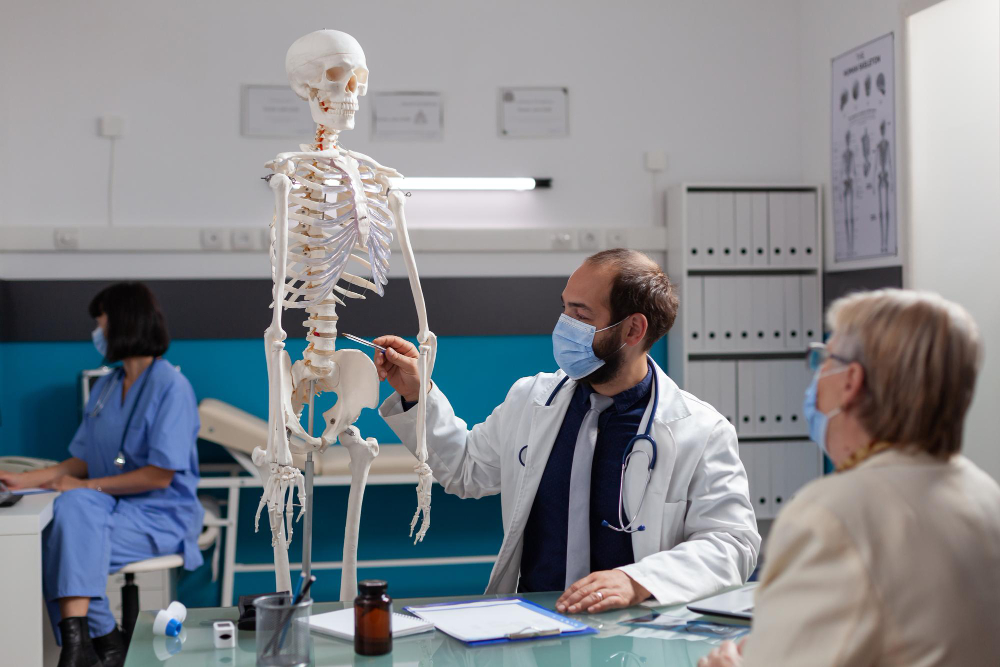골조직 번역(한국어 원본)Bisphosphonates는 osteoporosis, bone metastases, myeloma, fibrous dysplasia, Paget bone disease 등의 bone metabolism의 disorder를 치료하는데 널리 사용되는 약제이다. Bisphosphonate는 calcium에 대한 높은 친화성으로 hydroxyapatite (HA)와 강력하게 결합하면서 osteoclastic inhibitors로서 작용하며, 이는 합성 HA나 골조직 내의 천연 HA에서 모두 해당한다. 15
이와 같이, bisphosphonates 제재가 골흡수를 억제함으로써 골다공증 치료제로 사용되고 있기 때문에 골유합의 정상적인 과정을 저해할 수 있으며 일부 동물실험 결과 척추유합술에 악영향을 끼친다는 보고도 있고(a; 논문 인용) 일부에서는 골유합 부피는 감소하나 유합률에는 차이가 없다는 결과도 있다.(b: 논문 인용) 특히, 척추 수술의 경우 골이식을 통한 유합술이 많이 사용되며, 노령화 사회에 진입하면서 유합술을 필요로 하는 환자들이 증가하고 있다. 이와 함께, 골다공증 역시 증가하여 골다공증 치료와 척추유합술이 동시에 이루어지는 환자 또한 증가하고 있다. 또, 자가골 이식술의 공여부 합병증 등으로 골확장재가 많이 사용되고 있으며, 가장 대표적인 인공 골 확장재로 HA가 있다. 일부 연구에서는 ibandronate가 HA-coated implant의 osseointegration을 accelerate 시킨다고 알려져 있으며,2 세라믹스와 골과의 결합에 대한 비스포스포네이트 제재의 영향에 대해 몇몇 연구가 있으나 bioactive glass ceramics에 대한 연구는 없는 실정이다. HA는 높은 biocompatilibity와 osteoconductivity로 bone graft extender로 널리 사용되고 있으며 implant 표면에 코팅 함으로써 osseointegration을 증가시키는 것으로 알려져 있다. CaO-SiO2-P2O5-B2O3 glass ceramics는 이전에 저자가 보고한 CaO-SiO2-B2O3 glass ceramics8의 흡수성은 낮추면서 골과의 결합은 증가시킨 조성이다9(e: 논문 인용, KSSS). 이 CaO-SiO2-P2O5-B2O3 glass ceramics의 mechanical strength는 HA보다 높으며, 이 중 하중을 받는 부분에서 잘 흡수되지 않는 물성을 지니도록 기계적 강도를 높이고 흡수성을 낮춘 조성을 BGS-7으로 명명하였고, BGS-7의 압축강도는 HA에 비해 1.6배 정도 강하고 굴곡강도는 5배 정도 강한 것으로 알려져 있다 (저자들의 비공개 자료에 근거). 더욱이 BGS-7은 rat을 이용한 subchronic intravenous toxicity study에서 non-toxic하다고 알려져 있어(accepted for publication) bone graft extender로서의 가능성이 있는 물질이다.
이에, 본 연구는 현재 상용되는 비스포스포네이트 제재인 alendronate가 생체활성 세라믹스인 hydroxyapatite와 새로운 종류의 bioactive glass-ceramics인 BGS-7의 human bone marrow mesenchymal stem cell의 osteoblast differentiation에 어떤 영향을 미치는 지 알아보고자 한다. |
골조직 번역(영어 번역본)Bisphosphonates are drugs used widely in the treatment of bone metabolism disorders such as osteoporosis, bone metastases, myeloma, fibrous dysplasia, and Paget bone disease. With the high compatibility with calcium, bisphosphonates bind strongly to hydroxyapatite (HA) to act as osteoblastic inhibitors, and such applies to both synthetic HA and natural HA within the bones. 15
Likely, bisphosphonates that inhibit bone resorption are used in the treatment of osteoporosis, and thus may hinder the normal process of osseointegration, and some animal testing results have reported that bisphosphonates can have negative effects on spine fusion (a; citing) and some results argue that volume decreases but has no difference in fusion rate (b; citing). Especially, osseointegration through bone graft is used frequently in spine surgery, and the number of patients needing osseointegration has been increasing in our rapidly aging society. Moreover, the incidence of osteoporosis has also increased, which leads to an increase in the number of patients receiving treatment for osteoporosis while achieving osseointegration. Also, bone graft extenders are used widely to avoid donor site complications of iliac bone grafting, and the most representative artificial bone graft extender is hydroxyapatite (HA). Some studies point out that alendronate accelerates the osseointegration of HA-coated implant2, and there have been a couple of researches on the effects of bisphosphonates on the integration between ceramics and bones but there has been no studies done on bioactive glass ceramics. HA is used widely as a bone graft extender with its high biocompatibility and osteoconductivity, and is known to increase osseointegration by creating a coating on implant surface. CaO-SiO2-P2O5-B2O3 glass ceramics is a new formation9 (e: citing, KSSS) that has enhanced osseointegration while lowering the bone resorption of CaO-SiO2-B2O3 glass ceramics8 that the authors have reported previously. The mechanical strength of this CaO-SiO2-P2O5-B2O3 glass ceramics is greater than HA, and the name, BGS-7, was assigned to such a new formation that has increased mechanical strength and lowered bone resorption to have a physical property that is less resorptive in the load-bearing area. BGS-7 possesses compressive strength that is known to be 1.6 times greater and the flexural strength about 5 times greater than HA (based on the non-public reference of the authors). Moreover, BGS-7 has been proven to be non-toxic in the subchronic intravenous toxicity study using rats (accepted for publication), and thus has much potential to be used as a bone graft extender.
Therefore, this study intends to inquire into the effects alendronate, a bisphosphonate, has on the osteoblastic differentiation of human bone marrow mesenchymal stem cells when used on hydroxyapatite, a bioactive ceramics, and BGS-7, a new type of bioactive glass-ceramics. |
